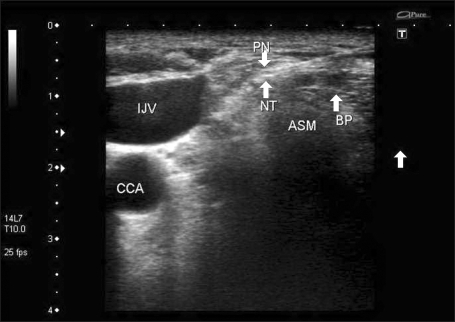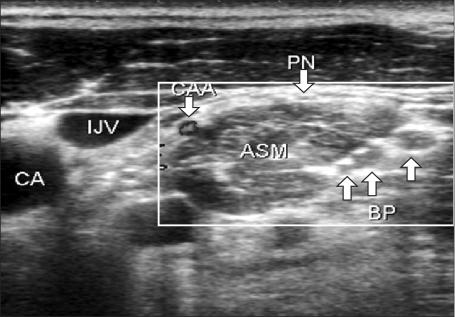Korean J Pain.
2010 Sep;23(3):198-201. 10.3344/kjp.2010.23.3.198.
Ultrasound-guided Pulsed Radiofrequency Lesioning of the Phrenic Nerve in a Patient with Intractable Hiccup
- Affiliations
-
- 1Department of Anesthesiology and Pain Medicine, Asan Medical Center, University of Ulsan College of Medicine, Seoul, Korea. sjinwoo@hotmail.com
- KMID: 1767881
- DOI: http://doi.org/10.3344/kjp.2010.23.3.198
Abstract
- Persistent and intractable hiccups (with respective durations of more than 48 hours and 1 month) can result in depression, fatigue, impaired sleep, dehydration, weight loss, malnutrition, and aspiration syndromes. The conventional treatments for hiccups are either non-pharmacological, pharmacological or a nerve block treatment. Pulsed radiofrequency lesioning (PRFL) has been proposed for the modulation of the excited nervous system pathway of pain as a safe and nondestructive treatment method. As placement of the electrode in close proximity to the targeted nerve is very important for the success of PRFL, ultrasound appears to be well suited for this technique. A 74-year-old man suffering from intractable hiccups that had developed after a coronary artery bypass graft and had continued for 7 years was referred to our pain clinic. He had not been treated with conventional methods or medications. We performed PRFL of the phrenic nerve guided by ultrasound and the hiccups disappeared.
Keyword
MeSH Terms
Figure
Cited by 3 articles
-
Phrenic Nerve Clipping in a Stroke Patient with Intractable Hiccup: a Case Report
Jung Ro Yoon, Yun Dam Ko, Soo In Yun, Myung Eun Chung
Brain Neurorehabil. 2018;11(1):. doi: 10.12786/bn.2018.11.e2.A Case of Pneumothorax after Phrenic Nerve Block with Guidance of a Nerve Stimulator
Serbülent Gökhan Beyaz, Adnan Tüfek, Orhan Tokgöz, Haktan Karaman
Korean J Pain. 2011;24(2):105-107. doi: 10.3344/kjp.2011.24.2.105.Pulsed Radiofrequency Lesioning of the Axillary and Suprascapular Nerve in Calcific Tendinitis
Jun Sik Kim, Francis Sahngun Nahm, Eun Joo Choi, Pyung Bok Lee, Guen Young Lee
Korean J Pain. 2012;25(1):60-64. doi: 10.3344/kjp.2012.25.1.60.
Reference
-
1. Homer JR, Davies JM, Amundsen LB. Persistent hiccups after attempted interscalene brachial plexus block. Reg Anesth Pain Med. 2005; 30:574–576. PMID: 16326344.
Article2. Cymet TC. Retrospective analysis of hiccups in patients at a community hospital from 1995-2000. J Natl Med Assoc. 2002; 94:480–483. PMID: 12078929.3. Pooran N, Lee D, Sideridis K. Protracted hiccups due to severe erosive esophagitis: a case series. J Clin Gastroenterol. 2006; 40:183–185. PMID: 16633116.4. Cosman ER Jr, Cosman ER Sr. Electric and thermal field effects in tissue around radiofrequency electrodes. Pain Med. 2005; 6:405–424. PMID: 16336478.
Article5. Nguyen M, Wilkes D. Pulsed radiofrequency V2 treatment and intranasal sphenopalatine ganglion block: a combination therapy for atypical trigeminal neuralgia. Pain Pract. 2010; 10:370–374. PMID: 20492576.
Article6. Brull R, Perlas A, Cheng PH, Chan VW. Minimizing the risk of intravascular injection during ultrasound-guided peripheral nerve blockade. Anesthesiology. 2008; 109:1142. PMID: 19034116.
Article7. McFarling DA, Susac JO. Hoquet diabolique: intractable hiccups as a manifestation of multiple sclerosis. Neurology. 1979; 29:797–801. PMID: 221856.
Article8. Marshall JB, Landreneau RJ, Beyer KL. Hiccups: esophageal manometric features and relationship to gastroesophageal reflux. Am J Gastroenterol. 1990; 85:1172–1175. PMID: 2389728.10. Lee JH, Kim TY, Lee HW, Choi YS, Moon SY, Cheong YK. Treatment of intractable hiccups with an oral agent monotherapy of baclofen: a case report. Korean J Pain. 2010; 23:42–45. PMID: 20552072.
Article11. Tegeler ML, Baumrucker SJ. Gabapentin for intractable hiccups in palliative care. Am J Hosp Palliat Care. 2008; 25:52–54. PMID: 18292481.
Article12. Babacan A, Oztürk E, Kaya K. Relief of chronic refractory hiccups with glossopharyngeal nerve block. Anesth Analg. 1998; 87:980. PMID: 9768811.
Article13. Calvo E, Fernández-La Torre F, Brugarolas A. Cervical phrenic nerve block for intractable hiccups in cancer patients. J Natl Cancer Inst. 2002; 94:1175–1176. PMID: 12165648.
Article14. Chou CL, Chen CA, Lin SH, Huang HH. Baclofen-induced neurotoxicity in chronic renal failure patients with intractable hiccups. South Med J. 2006; 99:1308–1309. PMID: 17195438.
Article15. Canella C, Demondion X, Delebarre A, Moraux A, Cotten H, Cotton A. Anatomical study of phrenic nerve using ultrasound. Eur Radiol. 2010; 20:659–665. PMID: 19727747.
Article16. Cahana A, Vutskits L, Muller D. Acute differential modulation of synaptic transmission and cell survival during exposure to pulsed and continuous radiofrequency energy. J Pain. 2003; 4:197–202. PMID: 14622704.
Article17. Philip CN, Candido KD, Joseph NJ, Crystal GJ. Successful treatment of meralgia paresthetica with pulsed radiofrequency of the lateral femoral cutaneous nerve. Pain Physician. 2009; 12:881–885. PMID: 19787014.
- Full Text Links
- Actions
-
Cited
- CITED
-
- Close
- Share
- Similar articles
-
- Treatment of Lung Cancer-Related Intractable Hiccups Using Pulsed Radiofrequency: Clinical Experience
- Treatment of Postoperative Intractable Hiccup Patient with Unilateral Phrenic Nerve Block: A case report
- Ultrasound-guided Pulsed Radiofrequency Lesioning of the Ulnar Nerve in a Patient with Cubital Tunnel Syndrome: A case report
- Ultrasound-guided pulsed radiofrequency treatment for postherpetic neuralgia of supraorbital nerve: A case report
- Pulsed Radiofrequency Lesioning of Supraorbital and Supratrochlear Nerve in Postherpetic Neuralgia: A report of 2 cases



